2022 LINCOLN CORSAIR roof rack
[x] Cancel search: roof rackPage 10 of 676

Switching Intelligent Mode On and Off
.......................................................................313
Adjusting the Set Speed Tolerance - Vehicles With: Intelligent Adaptive
Cruise Control ...........................................
313
Adaptive Cruise Control – Troubleshooting .......................................................................
314
Driving Aids
Driver Alert .....................................................
317
Lane Keeping System .................................
318
Blind Spot Information System ................
324
Cross Traffic Alert ........................................
326
Steering .........................................................
330
Pre-Collision Assist ......................................
331
Drive Mode Control
What Is Drive Mode Control .....................
337
Selecting a Drive Mode .............................
337
Drive Modes ..................................................
337
Speed Sign Recognition
What Is Speed Sign Recognition ............
340How Does Speed Sign Recognition Work
......................................................................
340
Speed Sign Recognition Precautions .....
340
Speed Sign Recognition Limitations ......
340
Speed Sign Recognition Indicators .........
341
Setting the Speed Sign Recognition Speed Warning ......................................................
341
Setting the Speed Sign Recognition Speed Tolerance ....................................................
341
Speed Sign Recognition – Troubleshooting .......................................................................
341
Load Carrying
Rear Under Floor Storage .........................
343
Luggage Covers ..........................................
343
Roof Racks and Load Carriers .................
343
Load Limit ......................................................
345
Towing
Towing a Trailer ...........................................
350
Trailer Sway Control ....................................
351
Recommended Towing Weights .............
352
Essential Towing Checks ...........................
353Towing the Vehicle on Four Wheels -
Gasoline, 8-Speed Automatic
Transmission – 8F35/8F40 ..................
355
Towing the Vehicle on Four Wheels - Plug-In Hybrid Electric Vehicle (PHEV),
Automatic Transmission – HF45 .........
356
Driving Hints
Breaking-In ...................................................
359
Driving Economically ..................................
359
Driving Through Shallow Water ..............
359
Floor Mats .....................................................
360
Roadside Emergencies
Roadside Assistance ..................................
362
Hazard Flashers ...........................................
363
Fuel Shutoff ..................................................
363
Jump Starting the Vehicle .........................
364
Post-Crash Alert System ............................
367
Transporting the Vehicle ...........................
367
Customer Assistance
Getting the Services You Need ...............
369
In California (U.S. Only) ..............................
370
7
2022 Corsair (CTF) Canada/United States of America, enUSA, Edition date: 202106, First-Printing Table of Contents
Page 284 of 676
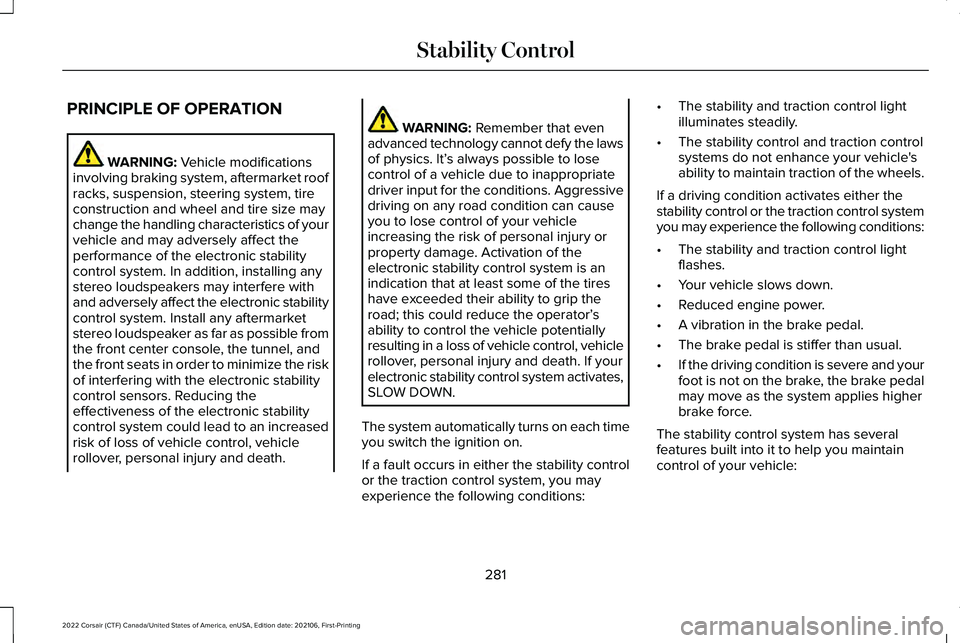
PRINCIPLE OF OPERATION
WARNING: Vehicle modifications
involving braking system, aftermarket roof
racks, suspension, steering system, tire
construction and wheel and tire size may
change the handling characteristics of your
vehicle and may adversely affect the
performance of the electronic stability
control system. In addition, installing any
stereo loudspeakers may interfere with
and adversely affect the electronic stability
control system. Install any aftermarket
stereo loudspeaker as far as possible from
the front center console, the tunnel, and
the front seats in order to minimize the risk
of interfering with the electronic stability
control sensors. Reducing the
effectiveness of the electronic stability
control system could lead to an increased
risk of loss of vehicle control, vehicle
rollover, personal injury and death. WARNING:
Remember that even
advanced technology cannot defy the laws
of physics. It’ s always possible to lose
control of a vehicle due to inappropriate
driver input for the conditions. Aggressive
driving on any road condition can cause
you to lose control of your vehicle
increasing the risk of personal injury or
property damage. Activation of the
electronic stability control system is an
indication that at least some of the tires
have exceeded their ability to grip the
road; this could reduce the operator’ s
ability to control the vehicle potentially
resulting in a loss of vehicle control, vehicle
rollover, personal injury and death. If your
electronic stability control system activates,
SLOW DOWN.
The system automatically turns on each time
you switch the ignition on.
If a fault occurs in either the stability control
or the traction control system, you may
experience the following conditions: •
The stability and traction control light
illuminates steadily.
• The stability control and traction control
systems do not enhance your vehicle's
ability to maintain traction of the wheels.
If a driving condition activates either the
stability control or the traction control system
you may experience the following conditions:
• The stability and traction control light
flashes.
• Your vehicle slows down.
• Reduced engine power.
• A vibration in the brake pedal.
• The brake pedal is stiffer than usual.
• If the driving condition is severe and your
foot is not on the brake, the brake pedal
may move as the system applies higher
brake force.
The stability control system has several
features built into it to help you maintain
control of your vehicle:
281
2022 Corsair (CTF) Canada/United States of America, enUSA, Edition date: 202106, First-Printing Stability Control
Page 346 of 676
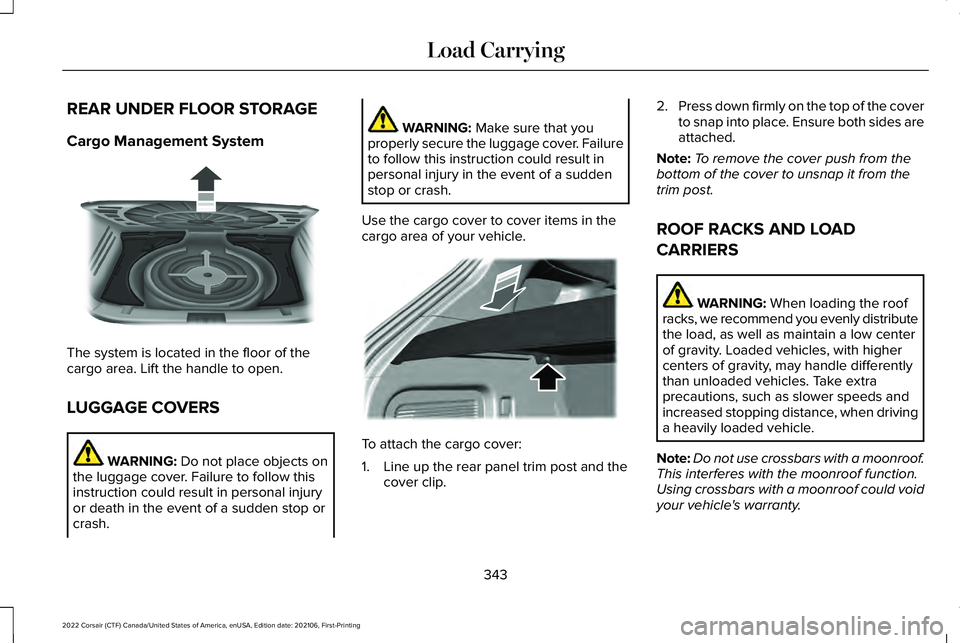
REAR UNDER FLOOR STORAGE
Cargo Management System
The system is located in the floor of the
cargo area. Lift the handle to open.
LUGGAGE COVERS
WARNING: Do not place objects on
the luggage cover. Failure to follow this
instruction could result in personal injury
or death in the event of a sudden stop or
crash. WARNING:
Make sure that you
properly secure the luggage cover. Failure
to follow this instruction could result in
personal injury in the event of a sudden
stop or crash.
Use the cargo cover to cover items in the
cargo area of your vehicle. To attach the cargo cover:
1. Line up the rear panel trim post and the
cover clip. 2.
Press down firmly on the top of the cover
to snap into place. Ensure both sides are
attached.
Note: To remove the cover push from the
bottom of the cover to unsnap it from the
trim post.
ROOF RACKS AND LOAD
CARRIERS WARNING:
When loading the roof
racks, we recommend you evenly distribute
the load, as well as maintain a low center
of gravity. Loaded vehicles, with higher
centers of gravity, may handle differently
than unloaded vehicles. Take extra
precautions, such as slower speeds and
increased stopping distance, when driving
a heavily loaded vehicle.
Note: Do not use crossbars with a moonroof.
This interferes with the moonroof function.
Using crossbars with a moonroof could void
your vehicle's warranty.
343
2022 Corsair (CTF) Canada/United States of America, enUSA, Edition date: 202106, First-Printing Load CarryingE142445 E299325
Page 347 of 676
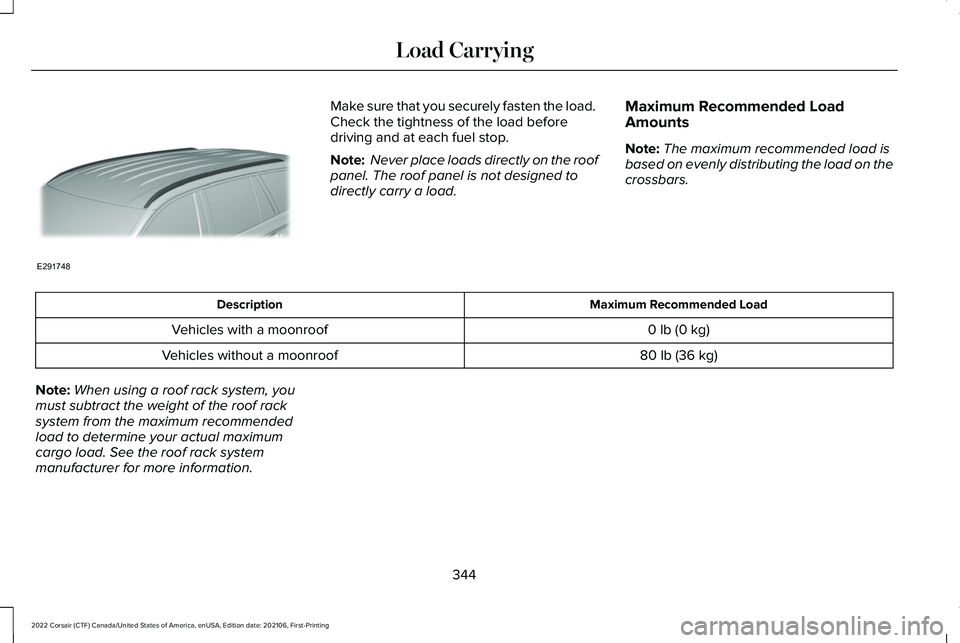
Make sure that you securely fasten the load.
Check the tightness of the load before
driving and at each fuel stop.
Note:
Never place loads directly on the roof
panel. The roof panel is not designed to
directly carry a load. Maximum Recommended Load
Amounts
Note:
The maximum recommended load is
based on evenly distributing the load on the
crossbars. Maximum Recommended Load
Description
0 lb (0 kg)
Vehicles with a moonroof
80 lb (36 kg)
Vehicles without a moonroof
Note: When using a roof rack system, you
must subtract the weight of the roof rack
system from the maximum recommended
load to determine your actual maximum
cargo load. See the roof rack system
manufacturer for more information.
344
2022 Corsair (CTF) Canada/United States of America, enUSA, Edition date: 202106, First-Printing Load CarryingE291748
Page 352 of 676
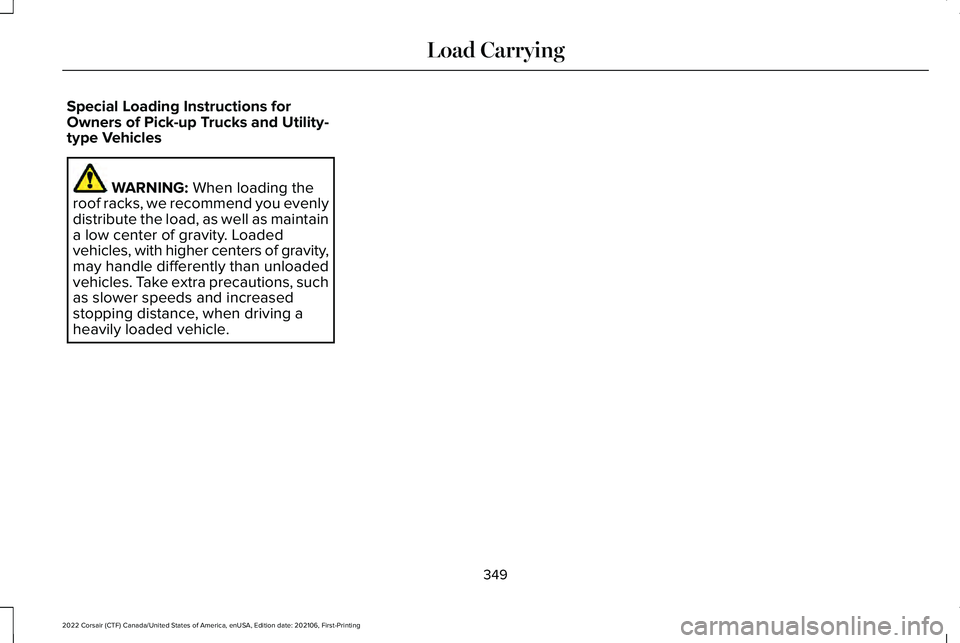
Special Loading Instructions for
Owners of Pick-up Trucks and Utility-
type Vehicles
WARNING: When loading the
roof racks, we recommend you evenly
distribute the load, as well as maintain
a low center of gravity. Loaded
vehicles, with higher centers of gravity,
may handle differently than unloaded
vehicles. Take extra precautions, such
as slower speeds and increased
stopping distance, when driving a
heavily loaded vehicle.
349
2022 Corsair (CTF) Canada/United States of America, enUSA, Edition date: 202106, First-Printing Load Carrying
Page 362 of 676

BREAKING-IN
Your vehicle requires a break-in period. For
the first 1,000 mi (1,600 km), avoid driving at
high speeds, heavy braking, aggressive
shifting or using your vehicle to tow. During
this time, your vehicle may exhibit some
unusual driving characteristics.
DRIVING ECONOMICALLY
The following helps to improve fuel
consumption:
•
Drive smoothly, accelerate gently and
anticipate the road ahead to avoid heavy
braking.
• Regularly check your tire pressures and
make sure that they are inflated to the
correct pressure.
• Follow the recommended maintenance
schedule and carry out the
recommended checks.
• Plan your journey and check the traffic
before you set off. It is more efficient to
combine errands into a single trip
whenever possible. •
Avoid idling the engine in cold weather
or for extended periods. Start the engine
only when you are ready to set off.
• Do not carry unnecessary weight in your
vehicle as extra weight wastes fuel.
• Do not add unnecessary accessories to
the exterior of your vehicle, for example
running boards. If you use a roof rack,
remember to fold it down or remove it
when not in use.
• Do not shift into neutral when you are
braking or when your vehicle is slowing
down.
• Shut all windows when driving at high
speeds.
• Switch off all electric systems when not
in use, for example air conditioning. Make
sure that you unplug any accessories
from the auxiliary power points when not
in use. DRIVING THROUGH SHALLOW
WATER WARNING: Do not attempt to cross
a deep or flowing body of water. Failure to
follow this instruction could result in the
loss of control of your vehicle, personal
injury or death.
Note: Driving through standing water can
cause vehicle damage.
Note: Engine damage can occur if water
enters the air filter.
Before driving through standing water, check
the depth. Never drive through water that is
higher than the bottom of the front rocker
area of your vehicle.
359
2022 Corsair (CTF) Canada/United States of America, enUSA, Edition date: 202106, First-Printing Driving Hints
Page 419 of 676

•
Do not allow wax to come in contact with
any non-body (low-gloss black) colored
trim. The wax will discolor or stain the
parts over time.
•Roof racks.
• Bumpers.
• Grained door handles.
• Side moldings.
• Mirror housings.
• Windshield cowl area.
• Do not apply wax to glass areas.
• After waxing, your car's paint should feel
smooth, and be free of streaks and
smudges.
CLEANING THE ENGINE
Engines are more efficient when they are
clean because grease and dirt buildup keep
the engine warmer than normal. When washing:
•
Take care when using a power washer
to clean the engine. The high-pressure
fluid could penetrate the sealed parts
and cause damage.
• Do not spray a hot engine with cold water
to avoid cracking the engine block or
other engine components.
• Spray Motorcraft Engine Shampoo and
Degreaser on all parts that require
cleaning and pressure rinse clean. In
Canada, use Motorcraft Engine Shampoo.
Note: If your vehicle has an engine cover
remove the cover before application of
Motorcraft Engine Shampoo and Degreaser.
Immediately rinse away any over spray.
• Never wash or rinse the engine while it
is hot or running; water in the running
engine may cause internal damage.
• Never wash or rinse any ignition coil,
spark plug wire or spark plug well, or the
area in and around these locations.
• Cover the battery, power distribution box,
and air filter assembly to prevent water
damage when cleaning the engine. CLEANING THE WINDOWS AND
WIPER BLADES
Car wash chemicals and environmental
fallout can result in windshield and wiper
blade contamination. Dirty windshield and
wipers will result in poor windshield wiper
operation. Keep the windshield and wiper
blades clean to maintain windshield wiper
performance.
To clean the windshield and wiper blades:
•
Clean the windshield with a non-abrasive
glass cleaner. When cleaning the interior
of the windshield, avoid getting any glass
cleaner on the instrument panel or door
panels. Wipe any glass cleaner off these
surfaces immediately.
• For windshields contaminated with tree
sap, chemicals, wax or bugs, clean the
entire windshield using steel wool (no
greater than 0000 grade) in a circular
motion and rinse with water.
• Clean the wiper blades with isopropyl
rubbing alcohol or windshield washer
concentrate.
416
2022 Corsair (CTF) Canada/United States of America, enUSA, Edition date: 202106, First-Printing Vehicle Care
Page 505 of 676
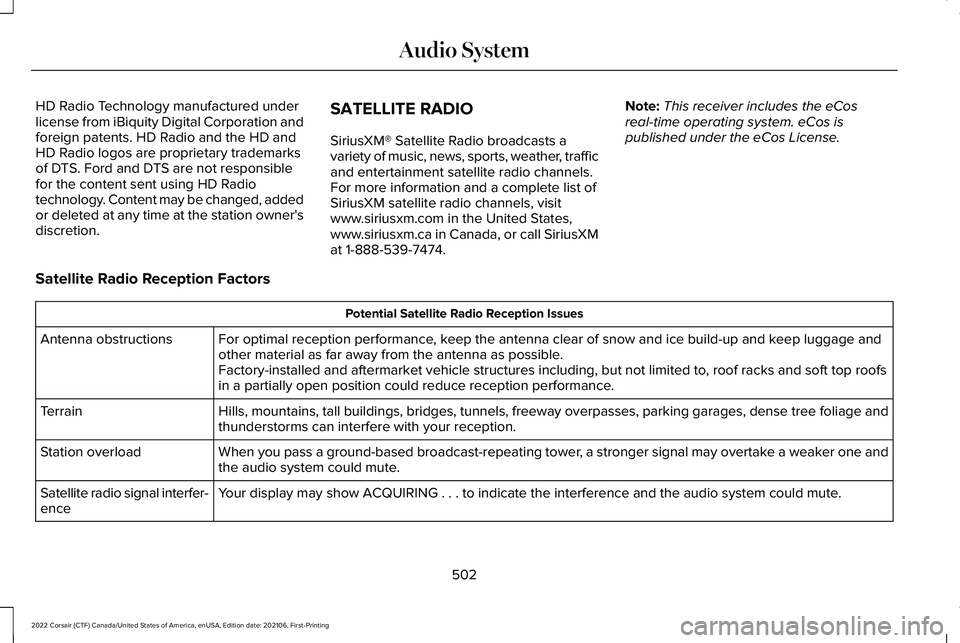
HD Radio Technology manufactured under
license from iBiquity Digital Corporation and
foreign patents. HD Radio and the HD and
HD Radio logos are proprietary trademarks
of DTS. Ford and DTS are not responsible
for the content sent using HD Radio
technology. Content may be changed, added
or deleted at any time at the station owner's
discretion.
SATELLITE RADIO
SiriusXM® Satellite Radio broadcasts a
variety of music, news, sports, weather, traffic
and entertainment satellite radio channels.
For more information and a complete list of
SiriusXM satellite radio channels, visit
www.siriusxm.com in the United States,
www.siriusxm.ca in Canada, or call SiriusXM
at 1-888-539-7474.Note:
This receiver includes the eCos
real-time operating system. eCos is
published under the eCos License.
Satellite Radio Reception Factors Potential Satellite Radio Reception Issues
For optimal reception performance, keep the antenna clear of snow and ice build-up and keep luggage and
other material as far away from the antenna as possible.
Factory-installed and aftermarket vehicle structures including, but not limited to, roof racks and soft top roofs
in a partially open position could reduce reception performance.
Antenna obstructions
Hills, mountains, tall buildings, bridges, tunnels, freeway overpasses, \
parking garages, dense tree foliage and
thunderstorms can interfere with your reception.
Terrain
When you pass a ground-based broadcast-repeating tower, a stronger signal may overtake a weaker one and
the audio system could mute.
Station overload
Your display may show ACQUIRING . . . to indicate the interference and th\
e audio system could mute.
Satellite radio signal interfer-
ence
502
2022 Corsair (CTF) Canada/United States of America, enUSA, Edition date: 202106, First-Printing Audio System